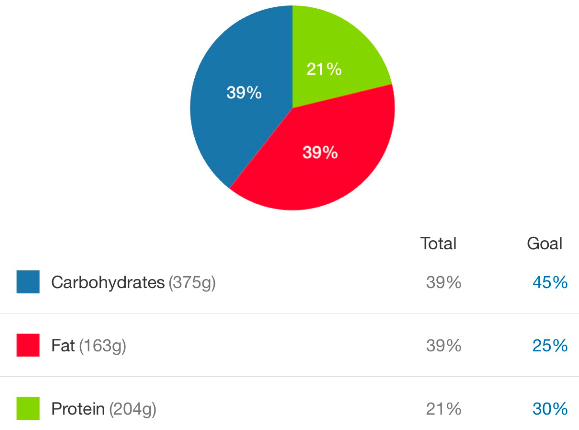- How Much Weight Can You Realistically Lose in 3 Months? - January 14, 2024
- How To Lose 1kg a Week (Guaranteed) - August 20, 2023
- How To Count Calories (or Estimate) and Stay on Track When Eating Out at Restaurants - July 25, 2023
Calorie ZigZaging is the process of eating different calorie amounts each day while sticking to an overall weekly average goal. This makes dieting much easier because it means you don’t need to stress about eating exactly the same amount each day, and it allows you to be more flexible in response to hunger, activity levels or social events.
So let’s say you sign up with a brand new trainer or coach.
You want to lose weight so they give you a calorie target to stick to.
You look at your target in horror as you gulp, smile politely and say thank you.
1,200 calories.
1,200 calories every single day.
Or at least as long as it takes for you to reach your goal weight.
That means every week needs to look like this;
| MON | TUES | WED | THURS | FRI | SAT | SUN |
| 1200 | 1200 | 1200 | 1200 | 1200 | 1200 | 1200 |
You wonder how the hell you’re going to stick to that, especially when you have a holiday coming up, a friend’s wedding in two weeks, plus nights out with work every few weeks.
Not fun.
Well, I’m not like other coaches and I have some good news for you.
You definitely DON’T need to eat exactly the same number of calories every day. That’s right, if your target is 1,200 calories for example, you don’t need to eat exactly 1,200 calories on the day your friends decide they want to go out drinking and eating Pizza all day
Enter the world of calorie cycling.
What is ZigZag Calorie Cycling?
Calorie cycling or ‘zigzagging’ your calories simply means eating different calorie amounts every day based on your needs, while sticking to an overall weekly calorie target (or an average daily target).
Over the course of a week, your calorie target would be the same, but you’d eat different amounts each day to hit that target. The target can either be a total, or a 7-day average.
Calorie Cycling Examples
This approach works really well because if your target is 1,200 calories per day you may have days when you’re super busy at work (let’s say Tuesday) and pretty much sitting at a desk all day.
On days like that, you may not need 1,200 calories, you might be able to get away with 800. What that means is, that you’ve banked 400 calories so you can use them on a different day.
So let’s say you get to Saturday and it turns out you’ve been invited out for dinner or drinks (or both), because you banked 400 calories on Tuesday, you use those on Saturday so you have 1,600 calories to play with.
This is how that might look;
| MON | TUES | WED | THURS | FRI | SAT | SUN |
| 1200 | 800 | 1200 | 1200 | 1200 | 1600 | 1200 |
And this is how zigzagging looks visually compared to static calorie restriction…

Dieting in this way doesn’t necessarily mean you’d need to do this every single week, you can of course mix and match weeks of calorie zigzagging with static calorie restriction.
Calorie Cycling: Different Options
Let’s look at a few other examples for how we could arrange the week if we had a 7-day average target of 1,200 calories
The robot
I call this the ‘robot’ because it simply involves eating exactly the same amount of calories every day in a robotic fashion.
There are very few people that actually do this, but if you’re super organised and focused, you may actually find this easier
| MON | TUES | WED | THURS | FRI | SAT | SUN |
| 1200 | 1200 | 1200 | 1200 | 1200 | 1200 | 1200 |
The weekend warrior
From working with dozens of clients, this is the most common calorie distribution pattern. Most people tend to eat more calories at the weekend, and less in the week.
Weekdays are on whole, filled with sitting at a desk working, for that reason it’s relatively easy to eat simply for fuel and function. Weekends on the other hand are generally dominated by social events, which more often than not are accompanied by food and drink.
If you were to eat 800 calories from Monday to Thursday, that means you saved a total of 2000 calories which you could spread even over Saturday and Sunday
| MON | TUES | WED | THURS | FRI | SAT | SUN |
| 800 | 800 | 800 | 800 | 800 | 2200 | 2200 |
Another option would be to dedicate everything you’ve saved through the week on Saturday and have an ‘average’ Sunday.
| MON | TUES | WED | THURS | FRI | SAT | SUN |
| 800 | 800 | 800 | 800 | 800 | 3200 | 1200 |
Alternate Day fasting
This is quite an extreme example because it means eating nothing all day, on certain days of the week. It does mean however that you can eat double your average daily target on the days when you do eat.
It’s also relatively easy to manage
| MON | TUES | WED | THURS | FRI | SAT | SUN |
| 2400 | 0 | 2400 | 0 | 2400 | 0 | 1200 |
The hot mess
In all honesty, this is probably the closest to the reality of all these methods. Most people do NOT eat the amount every day, nor can they plan ahead too far in advance
So their weekends up looking like this. And guess what, that’s not a problem because the average 7-day calorie intake is still 1,200 calories!
| MON | TUES | WED | THURS | FRI | SAT | SUN |
| 1476 | 1071 | 740 | 1000 | 1138 | 1987 | 988 |
WANT IN TO MY FREE 14-DAY FAT LOSS COURSE? PUT YOUR NAME AND EMAIL ADDRESS IN BELOW;
Is Calorie Cycling Better Than Regular Calorie Restriction; What Does the Science Say?
It really depends on the individual’s preferences as to whether straightforward calorie restriction, but based on the people I’ve worked with that have been successful, the answer is a resounding yes.
Most people will eat different amounts each day based on any number of reasons including;
- Hunger levels
- Planned activity
- Boredom
- Emotional eating
- Stress
- Tiredness
- Social events
For example, if you’re more hungry on a Tuesday for example, the chances are you’re going to your body’s natural signals and eat more on that particular day, especially if you know you can compensate for it later in the week
Similarly, if you’re hitting the gym or going for a run on a specific day, you’ll eat more beforehand to ensure you have enough energy to perform to your maximum ability. You might also eat more afterwards because your hunger has been stimulated.
If you have a social event on a particular day (usually the weekend) you’ll almost definitely consume more calories on that day.
But don’t take my word for it, listen to what the science has to say.
This 2014 study was carried out on 74 overweight individuals split into two groups. One group followed straightforward calorie restriction, while the other group followed a ‘calorie shifting’ diet, i.e. differing calorie amounts each day. The conclusion was that a ‘calorie shifting diet’ lead to better adherence and decreased feelings of hunger
The findings are backed by up by this 2010 study on thirty-six, overweight sedentary women. All women followed the same dieting pattern which consisted of consuming 1,200 calories for 1 week, followed by 1,500 calories for 3 weeks, and then 2,200 for 4 weeks. The pattern was then repeated for a further 30 days. All subjects lost weight but did not see any reduction in resting energy expenditure.
Finally, this review of randomized controlled trials showed that intermittent energy restriction had a superior effect on absolute and relative weight loss than straightforward static calorie restriction. It also had positive effects on metabolic rate.
So, there is clearly strong scientific evidence to support the efficacy of calorie ZigZagging.
Do You Need to Cycle Macros As well?

You might already be tracking Macros, so you probably want to know if you need to zigzag your macros as well as your calories.
The simple answer to this is ‘no’.
Ultimately, Macros don’t really matter when it comes to fat loss, and there’s no ‘perfect’ Macro split you need to stick to that will help you lose weight any quicker.
For the vast majority of people, I think a C40/P30/F30 split for Carbs, Protein and Fat works quite well, however, you your low-calorie days you may want to go even lower on fat than usual. This is because fat contains 9 calories per gram, so you don’t tend to get as much ‘bang for your buck’ when it comes fat as you do from Protein and Fat.
Consider something like oil or butter; very small amounts of these foods contain a LOT of calories, which means you won’t really feel full or satisfied, but you’ll have eaten into your calorie budget.
For this reason, you may want to go slightly lower on fat on your lower-calorie days to keep you feeling full. So on lower calorie days, a C40/P40/F20 split might be better. The additional protein will also help to keep you feeling full.
Pros and Cons of Calorie Cycling
As I’ve mentioned, the ZigZagging approach works for almost everyone I’ve worked with, and the pros massively outweigh the cons. Nevertheless, there may be some people this doesn’t work well for
Pros
- No pressure to eat a precise amount each day
- No guilt if you don’t meet a precise daily target
- Ability to compensate if you overeat on one or several days
- Easy to accommodate social events
- Easy to eat less during the week and more at weekends
Cons
- May not work as well if you like a regimented, consistent approach
- May need to eat super low calories on Sunday if you’ve overeaten all week
- Need to keep an eye on either the 7-day average target or your cumulative total calories
This is not to say that Zigzagging is best for everyone. If you value not having to think ahead or plan based on your natural daily calorie intake over and above freedom and flexibility then regular calorie restriction may be better for you.
The Calorie ZigZag Diet
There is no specific ‘Calorie ZigZag Diet’.
In fact, the whole point of calorie ZigZagging is that you don’t need to stick to a specific framework, which gives you the freedom and flexibility to eat what you want, when you want (as long as you’re sticking to your 7-day average targets).
Having said that, it does definitely make sense to vary WHAT you eat if you know you’re going to have a low-calorie day.
So, if we continue with the previous example and assume that your 7-day average target is 1,200 calories, a low-calorie day might be 800 calories, and a high-calorie day might be 1,600 calories.
Now, 800 calories is obviously very low, so on those days you want to ensure that you’re eating high-volume, filling foods.
If you don’t, and you stick to stuff like Pizza, Ice Cream, Cake and Donuts, you’re not gonna have a good time.
Why?
Well, a typical slice of Pizza is 250 calories, and a Donut is around 300 calories. That means on your 800 calories, you’ll be able to eat 2 slices of Pizza and a Donut.
That’s obviously just not practical.
So, the solution is to eat low-calorie-dense, high-volume foods on your lower-calorie days.
These are the types of foods you should stick to;
| FOOD | CALORIE DENSITY (KCAL/G) |
| Lettuce | 0.15 |
| Spinach | 0.23 |
| Watermelon | 0.3 |
| Strawberry | 0.32 |
| Carrot | 0.4 |
| Orange | 0.48 |
| 2% Fat Milk | 0.5 |
| Apple | 0.52 |
| Grapes | 0.69 |
| Boiled Potato | 0.87 |
| Banana | 0.89 |
| Ketchup | 1 |
| Chicken Breast (No Skin) | 1.1 |
| Brown Rice | 1.1 |
| White Fish (Tilapia) | 1.13 |
| Tuna | 1.16 |
| White Rice | 1.3 |
| Pasta (Spaghetti) | 1.31 |
| Pork Loin | 1.36 |
| Quiona | 1.43 |
| Salmon | 1.45 |
| Egg | 1.48 |
| Avocado | 1.6 |
| Whole Wheat Bread | 2.48 |
| Steak | 2.5 |
| White Bread | 2.64 |
| Burger Patty | 2.82 |
| Mozarella | 3 |
| Raisins | 3 |
| Fries | 3.07 |
| Black Beans | 3.41 |
| Frosties | 3.67 |
| Mayonaise | 3.86 |
| Nutella | 5.41 |
| Peanuts | 6 |
| Butter | 7.21 |
| Olive Oil | 8.85 |
Other Calorie ZigZaging FAQs
Got more questions about calorie ZigZagging? I’ve probably answered them below, but if not, feel free to drop a comment or just get in touch with me!
Can Calorie ZigZagging Help You Break Weight Loss Plateaus?
Probably not. If you’re experiencing a weight loss plateau, what you’ll likely need to do is drop your calories a little, or increase your activity. ZigZagging your calories might help you stick to a new, reduced-calorie target but ZigZagging on its own won’t directly help you break through a plateau.
The other thing you could do is take a short diet break which may help raise your metabolism slightly, then get back to your calorie deficit.
Does The ZigZag Calorie Diet Work?
As long as you’re in a calorie deficit consistently over a long period of time (minimum 4 weeks), then yes, ZigZagging your calories WILL work. I’ve helped dozens of people achieve their weight loss goals and every single one of them has ZigZagged their calories!
What are the Benefits of the Calorie ZigZag Diet?
The main benefit of the calorie ZigZag diet is that it makes calorie restriction MUCH easier to fit around your lifestyle. It means you don’t need to say no to social events, or stop drinking alcohol completely, or give up that weekend takeaway. In short, it makes dieting easier, more fun and generally a much more sustainable way to lose weight.
Conclusion
ZigZagging or ‘Cycling’ your calories is a sensible strategy for almost anyone that’s attempting to stick to a calorie deficit.
It allows for much more flexibility and freedom than simply sticking to exactly the same amount of calories every day, which means you can have spontaneous bouts of high-calorie intake as a result of social events or unexpected high hunger levels.
The best way to stick to a ZigZag calorie diet is to have either a 7-day average target or a total weekly calorie target, rather than strict daily targets.
References
https://www.ncbi.nlm.nih.gov/pmc/articles/PMC4018593/



Leave a Reply